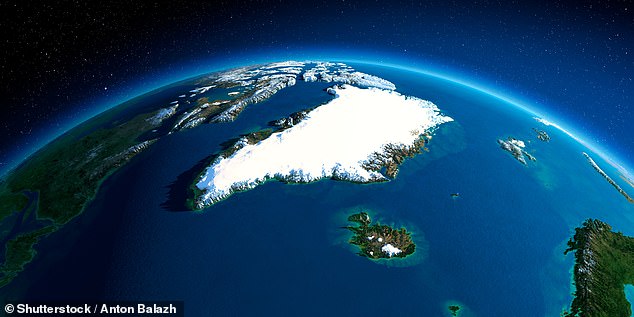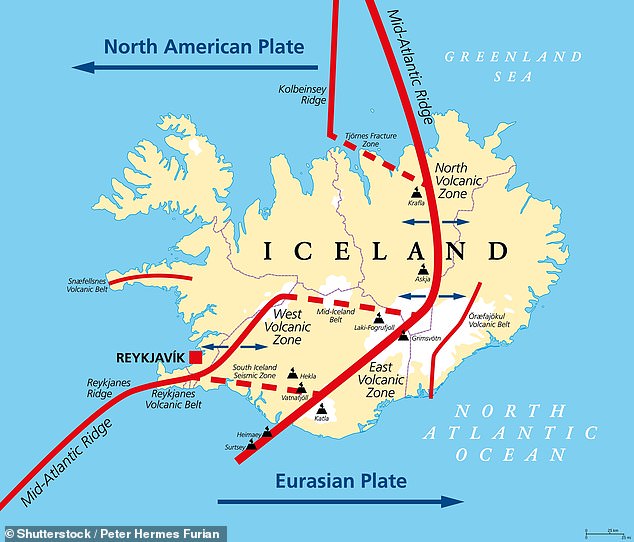North America and Europe should be classed as ONE continent, scientists claim in controversial new study
Growing up, most of us were taught that the Earth has seven continents.
But it may be time to rewrite the geography textbooks, as a controversial study now claims there are actually only six continents.
According to researchers from the University of Derby, the split between the European and North American continents is still ongoing.
Dr Jordan Phethean, one of the study’s authors, said: ‘The discovery indicates that the North American and Eurasian tectonic plates have not yet actually broken apart, as is traditionally thought to have happened 52 million years ago.
“They’re still stretching and breaking down.”
Growing up, most of us were taught that the Earth is home to seven continents. But it may be time to rewrite those geography textbooks, as a controversial study now claims that there are actually only six continents

The new study focused on the formation of Iceland, which lies between the Greenland Sea and the North Atlantic Ocean
The new study focused on the formation of Iceland, which lies between the Greenland Sea and the North Atlantic Ocean.
Until now, it was widely believed that Iceland formed about 60 million years ago when the Mid-Atlantic Ridge – the boundary between the North American and Eurasian tectonic plates – began to move apart, creating a hot mantle plume that developed into a volcanic island.
However, in their new research, the team disputes this theory.
By analyzing the movement of tectonic plates in Africa, the researchers now suggest that Iceland and the Greenland-Faroe Islands Ridge (GIFR) also contain pieces of lost and submerged fragments of both the European and North American continents.
They call this newly discovered feature a ‘Rifted Oceanic Magmatic Plateau’, or ROMP for short.
“I like to think of this concept as the Earth science equivalent of finding the Lost City of Atlantis; fragments of a lost continent beneath the sea and miles of thin lava flows,” Dr. Phethean explains.
‘By studying the evolution of the faults in the Afra volcanic region in Africa and comparing this with the behaviour of the Earth in Iceland, we can see that these two regions develop in a very similar way.’

Until now, it was widely believed that Iceland formed about 60 million years ago when the Mid-Atlantic Ridge – the boundary between the North American and Eurasian tectonic plates – began to move apart, creating a hot mantle plume that formed into a volcanic island.
If the researchers are correct, this means that the split between the European and North American continents is still ongoing.
Scientifically, this would mean that North America and Europe could be considered one continent, rather than two continents.
‘While it is controversial to claim that the GIFR contains a large amount of continental crust, and that the European and North American tectonic plates may not yet have officially broken up, our findings suggest that this is the case,’ added Dr Phethean.
The findings are still conceptual, but the researchers plan to examine the volcanic rocks in Iceland for more concrete evidence of ancient continental crust.
They are also conducting a plate tectonic model of the area and will use computer simulations to model the ROMP formation.
The news came shortly after Dr Phethean was part of a research team that discovered a new ‘proto-microcontinent’ between Canada and Greenland, thought to have formed 60 million years ago.
The proto-microcontinent is 400 kilometers long – about the size of England – and currently lies beneath the Davis Strait, which connects the Labrador Sea in the south to Baffin Bay in the north.
“Fracture formation and the formation of microcontinents are ongoing phenomena,” said Dr. Phethean.
‘The discovery of the proto-microcontinent in Davis Strait gives us more insight into the formation process of microcontinents, which in turn gives us more insight into the functioning of plate tectonics on Earth.
‘This will allow scientists to better predict where useful raw materials can be found, what the Earth might look like in millions of years, and how plate tectonics functioned in the early history of the Earth, and what role it might have played in the development of life.’
